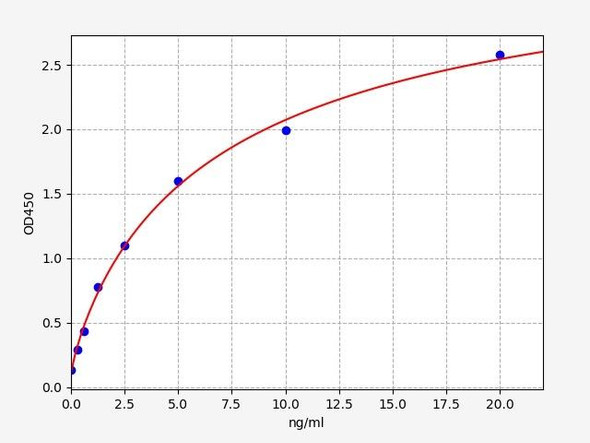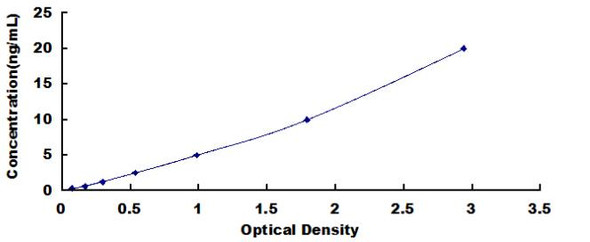Mouse Cell Signalling ELISA Kits 5
Mouse DRD1 / Dopamine Receptor D1 ELISA Kit
- SKU:
- MOFI00396
- Product Type:
- ELISA Kit
- Size:
- 96 Assays
- Uniprot:
- Q61616
- Sensitivity:
- 0.094ng/ml
- Range:
- 0.156-10ng/ml
- ELISA Type:
- Sandwich
- Synonyms:
- Drd1, D1R, DRD1, Dopamine Receptor D1, D, 1A dopamine receptor, Dopamine D1 receptor
- Reactivity:
- Mouse
Description
| Product Name: | Mouse DRD1 / Dopamine Receptor D1 ELISA Kit |
| Product Code: | MOFI00396 |
| Size: | 96 Assays |
| Alias: | Drd1, D1R, DRD1, Dopamine Receptor D1, D, 1A dopamine receptor, Dopamine D1 receptor |
| Detection Method: | Sandwich ELISA |
| Application: | This immunoassay kit allows for the in vitro quantitative determination of Mouse Drd1 concentrations in serum plasma and other biological fluids. |
| Sensitivity: | 0.094ng/ml |
| Range: | 0.156-10ng/ml |
| Storage: | 4°C for 6 months |
| Note: | For Research Use Only |
| Recovery: | Matrices listed below were spiked with certain level of Mouse Drd1 and the recovery rates were calculated by comparing the measured value to the expected amount of Mouse Drd1 in samples. | ||||||||||||||||
| |||||||||||||||||
| Linearity: | The linearity of the kit was assayed by testing samples spiked with appropriate concentration of Mouse Drd1 and their serial dilutions. The results were demonstrated by the percentage of calculated concentration to the expected. | ||||||||||||||||
| |||||||||||||||||
| Intra Assay: | CV <8% | ||||||||||||||||
| Inter Assay: | CV <10% |
| Component | Quantity | Storage |
| ELISA Microplate (Dismountable) | 8-12 strips | 4°C for 6 months |
| Lyophilized Standard | 2 | 4°C/-20°C |
| Sample/Standard Dilution Buffer | 20ml | 4°C |
| Biotin-labeled Antibody(Concentrated) | 120ul | 4°C (Protect from light) |
| Antibody Dilution Buffer | 10ml | 4°C |
| HRP-Streptavidin Conjugate(SABC) | 120ul | 4°C (Protect from light) |
| SABC Dilution Buffer | 10ml | 4°C |
| TMB Substrate | 10ml | 4°C (Protect from light) |
| Stop Solution | 10ml | 4°C |
| Wash Buffer(25X) | 30ml | 4°C |
| Plate Sealer | 5 | - |
Other materials and equipment required:
- Microplate reader with 450 nm wavelength filter
- Multichannel Pipette, Pipette, microcentrifuge tubes and disposable pipette tips
- Incubator
- Deionized or distilled water
- Absorbent paper
- Buffer resevoir
| Uniprot | Q61616 |
| UniProt Protein Function: | DRD1: a G-protein coupled receptor.One of the five types (D1 to D5) of receptors for dopamine. The most abundant dopamine receptor in the central nervous system. The activity of this receptor is mediated by G proteins which activate adenylyl cyclase. Interacts with calcyon. |
| UniProt Protein Details: | Protein type:Receptor, GPCR; Membrane protein, multi-pass; GPCR, family 1; Membrane protein, integral Chromosomal Location of Human Ortholog: 5q35.1 Cellular Component: endoplasmic reticulum membrane; integral to plasma membrane; plasma membrane; nucleus Molecular Function:protein binding; dopamine receptor activity; dopamine binding; dopamine D1 receptor-like receptor activity Biological Process: synaptic transmission, dopaminergic; peristalsis; elevation of cytosolic calcium ion concentration during G-protein signaling, coupled to IP3 second messenger (phospholipase C activating); behavioral fear response; prepulse inhibition; positive regulation of potassium ion transport; generation of action potential; thermoregulation; G-protein signaling, adenylate cyclase activating pathway; vasodilation; positive regulation of synaptic transmission, glutamatergic; adult walking behavior; dopamine metabolic process; synaptogenesis; behavioral response to cocaine; protein import into nucleus; conditioned taste aversion; positive regulation of cAMP biosynthetic process; visual learning; dopamine receptor, adenylate cyclase activating pathway; grooming behavior; response to drug; dopamine transport; dentate gyrus development; cerebral cortex GABAergic interneuron migration; striatum development; maternal behavior; response to amphetamine; adenylate cyclase activation; regulation of dopamine metabolic process; mating behavior; regulation of dopamine uptake; transmission of nerve impulse; astrocyte development; memory; G-protein signaling, coupled to cyclic nucleotide second messenger; habituation; glucose import; operant conditioning; sensitization; positive regulation of release of sequestered calcium ion into cytosol; dopamine receptor, phospholipase C activating pathway; positive regulation of cell migration |
| NCBI Summary: | This gene encodes the D1 subtype of the dopamine receptor. The D1 subtype is the most abundant dopamine receptor in the central nervous system. This G-protein coupled receptor stimulates adenylyl cyclase and activates cyclic AMP-dependent protein kinases. D1 receptors regulate neuronal growth and development, mediate some behavioral responses, and modulate dopamine receptor D2-mediated events. Alternate transcription initiation sites result in two transcript variants of this gene. [provided by RefSeq, Jul 2008] |
| UniProt Code: | Q61616 |
| NCBI GenInfo Identifier: | 118228 |
| NCBI Gene ID: | 1812 |
| NCBI Accession: | P21728.1 |
| UniProt Secondary Accession: | Q61616,Q61616, P18901, |
| UniProt Related Accession: | P21728 |
| Molecular Weight: | 75kDa |
| NCBI Full Name: | D(1A) dopamine receptor |
| NCBI Synonym Full Names: | dopamine receptor D1 |
| NCBI Official Symbol: | DRD1 |
| NCBI Official Synonym Symbols: | DADR; DRD1A |
| NCBI Protein Information: | D(1A) dopamine receptor |
| UniProt Protein Name: | D(1A) dopamine receptor |
| UniProt Synonym Protein Names: | Dopamine D1 receptor |
| Protein Family: | D(1A) dopamine receptor |
| UniProt Gene Name: | DRD1 |
| UniProt Entry Name: | DRD1_HUMAN |
*Note: Protocols are specific to each batch/lot. For the correct instructions please follow the protocol included in your kit.
| Step | Procedure |
| 1. | Set standard, test sample and control (zero) wells on the pre-coated plate respectively, and then, record their positions. It is recommended to measure each standard and sample in duplicate. Wash plate 2 times before adding standard, sample and control (zero) wells! |
| 2. | Aliquot 0.1ml standard solutions into the standard wells. |
| 3. | Add 0.1 ml of Sample / Standard dilution buffer into the control (zero) well. |
| 4. | Add 0.1 ml of properly diluted sample (Human serum, plasma, tissue homogenates and other biological fluids.) into test sample wells. |
| 5. | Seal the plate with a cover and incubate at 37 °C for 90 min. |
| 6. | Remove the cover and discard the plate content, clap the plate on the absorbent filter papers or other absorbent material. Do NOT let the wells completely dry at any time. Wash plate X2. |
| 7. | Add 0.1 ml of Biotin- detection antibody working solution into the above wells (standard, test sample & zero wells). Add the solution at the bottom of each well without touching the side wall. |
| 8. | Seal the plate with a cover and incubate at 37°C for 60 min. |
| 9. | Remove the cover, and wash plate 3 times with Wash buffer. Let wash buffer rest in wells for 1 min between each wash. |
| 10. | Add 0.1 ml of SABC working solution into each well, cover the plate and incubate at 37°C for 30 min. |
| 11. | Remove the cover and wash plate 5 times with Wash buffer, and each time let the wash buffer stay in the wells for 1-2 min. |
| 12. | Add 90 µL of TMB substrate into each well, cover the plate and incubate at 37°C in dark within 10-20 min. (Note: This incubation time is for reference use only, the optimal time should be determined by end user.) And the shades of blue can be seen in the first 3-4 wells (with most concentrated standard solutions), the other wells show no obvious color. |
| 13. | Add 50 µL of Stop solution into each well and mix thoroughly. The color changes into yellow immediately. |
| 14. | Read the O.D. absorbance at 450 nm in a microplate reader immediately after adding the stop solution. |
When carrying out an ELISA assay it is important to prepare your samples in order to achieve the best possible results. Below we have a list of procedures for the preparation of samples for different sample types.
| Sample Type | Protocol |
| Serum: | If using serum separator tubes, allow samples to clot for 30 minutes at room temperature. Centrifuge for 10 minutes at 1,000x g. Collect the serum fraction and assay promptly or aliquot and store the samples at -80°C. Avoid multiple freeze-thaw cycles. If serum separator tubes are not being used, allow samples to clot overnight at 2-8°C. Centrifuge for 10 minutes at 1,000x g. Remove serum and assay promptly or aliquot and store the samples at -80°C. Avoid multiple freeze-thaw cycles. |
| Plasma: | Collect plasma using EDTA or heparin as an anticoagulant. Centrifuge samples at 4°C for 15 mins at 1000 - g within 30 mins of collection. Collect the plasma fraction and assay promptly or aliquot and store the samples at -80°C. Avoid multiple freeze-thaw cycles. Note: Over haemolysed samples are not suitable for use with this kit. |
| Urine & Cerebrospinal Fluid: | Collect the urine (mid-stream) in a sterile container, centrifuge for 20 mins at 2000-3000 rpm. Remove supernatant and assay immediately. If any precipitation is detected, repeat the centrifugation step. A similar protocol can be used for cerebrospinal fluid. |
| Cell culture supernatant: | Collect the cell culture media by pipette, followed by centrifugation at 4°C for 20 mins at 1500 rpm. Collect the clear supernatant and assay immediately. |
| Cell lysates: | Solubilize cells in lysis buffer and allow to sit on ice for 30 minutes. Centrifuge tubes at 14,000 x g for 5 minutes to remove insoluble material. Aliquot the supernatant into a new tube and discard the remaining whole cell extract. Quantify total protein concentration using a total protein assay. Assay immediately or aliquot and store at ≤ -20°C. |
| Tissue homogenates: | The preparation of tissue homogenates will vary depending upon tissue type. Rinse tissue with 1X PBS to remove excess blood & homogenize in 20ml of 1X PBS (including protease inhibitors) and store overnight at ≤ -20°C. Two freeze-thaw cycles are required to break the cell membranes. To further disrupt the cell membranes you can sonicate the samples. Centrifuge homogenates for 5 mins at 5000xg. Remove the supernatant and assay immediately or aliquot and store at -20°C or -80°C. |
| Tissue lysates: | Rinse tissue with PBS, cut into 1-2 mm pieces, and homogenize with a tissue homogenizer in PBS. Add an equal volume of RIPA buffer containing protease inhibitors and lyse tissues at room temperature for 30 minutes with gentle agitation. Centrifuge to remove debris. Quantify total protein concentration using a total protein assay. Assay immediately or aliquot and store at ≤ -20 °C. |
| Breast Milk: | Collect milk samples and centrifuge at 10,000 x g for 60 min at 4°C. Aliquot the supernatant and assay. For long term use, store samples at -80°C. Minimize freeze/thaw cycles. |






